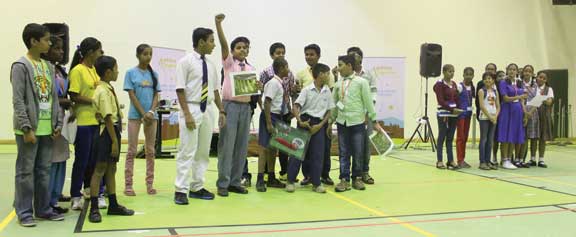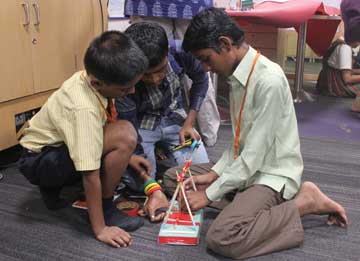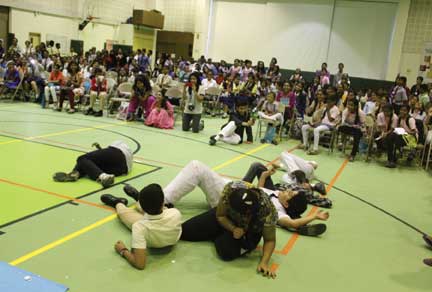Fiona Vaz
In the past few years, considerable attention has been paid to improving the educational outcomes for children. Schools serving students from all socio-economic backgrounds are expending more efforts to improve learning outcomes and to create adults who can flourish at a global scale. However, schools in India tend to be quite resistant to change. Pedagogies that have seemed effective continue to be used since teachers and schools get comfortable and better versed with the methods that they are familiar with.
Amidst the pulls of staying with what has worked in the past and the push of wanting to adopt the new, traditional classrooms in urban, peri-urban and rural schools are trying out digital learning using projectors, smartboards, tablets and the Internet. Some schools are adopting alternative co-curricular and extra-curricular activities such as drama and theatre and sports to enhance student leadership, newer approaches to teaching STEM and to build critical thinking and so forth. All these learning methods, aim to change what has remained at the very core of the Indian education system – the culture of silence on the part of the students and the authority of the teacher as the sole person possessing and disseminating knowledge. Given all the efforts being made, in multiple directions, is an exploration on active learning even relevant?
According to Nilesh Nimkar, Founder and Director of QUEST Education in India that works with schools in rural Maharashtra, active learning is not a reality in most schools. “As far as rural elementary schools are concerned, the upper primary grades (6-8) largely depend on the old chalk and talk way of teaching, based on the prescribed textbook. There is some shift of approach visible in primary grades where teachers try to increase children’s active participation using some concrete materials or by planning group activities,” he says. Nilesh observes that these changes however are not consistent across grades and even across different student demographics. Those who are marginalized continue to be taught in methods that limit their participation in their own learning process. Students belonging to tribal families, for example, are engulfed in a culture of silence and consider the teacher as the centre of knowledge.

Active learning in schools and classrooms
Active learning is a form of learning when students are actively involved in their own learning process instead of being passive recipients of information shared by teachers. Active learning can involve students asking questions, participating in group work, demonstrating their learning through activities or constructing their own experiments to uncover scientific principles. Active learning democratizes the notion of who is the wielder of knowledge, as knowledge is constructed and built upon by everyone involved as opposed to being transmitted from one person to another or from one person to a group of others. It negates the position of the teacher and the textbook as the only source of knowledge, yet at the same time does not make the teacher redundant. The teacher’s role continues as one who plans lessons, directs students and facilitates their learning while at the same time increases the involvement of students. Active learning has several benefits apart from creating a culture where every voice is welcome. It helps students to think critically, builds their communication skills, and keeps them engaged in the learning process. It can, however, be time consuming. The process of discovery cannot be prescribed; a student’s ability to find his/her confidence and speak in class or even in a small group cannot be predicted. Hence, given the load of the syllabus to be completed within a time-frame, teachers might rely on the chalk and talk method where students’ involvement is limited.
Another deterrent for teachers to use active learning in classes could be the restricted definitions of what good classroom management is. Traditionally, good classroom management has entailed students sitting quietly in their seats, speaking in hushed tones, following teachers’ instructions and rarely asking questions. In fact, culturally, students asking questions to teachers can be seen at best as nuisance and at worst, an affront to the teacher’s authority.
 Prahlad Vitthal Kathole, Assistant Teacher at Zilla Parishad School Baliwali in Palghar, Maharashtra corroborates the above. In rural schools in Maharashtra where he works as a teacher as well as a teacher trainer, he says that although active learning can be used in various subjects, it is not being used. Teachers continue to teach in the way that they have been taught. Often, he says, that when teachers use active learning methods or deviate from the traditional teacher-centric methods, they are asked by the school leadership to stick to the textbook. “Untrained monitoring systems are the biggest hurdle in bringing about any changes in pedagogy,” says Prahlad, highlighting the role of school leadership in bringing any kind of progressive changes in the learning systems.
Prahlad Vitthal Kathole, Assistant Teacher at Zilla Parishad School Baliwali in Palghar, Maharashtra corroborates the above. In rural schools in Maharashtra where he works as a teacher as well as a teacher trainer, he says that although active learning can be used in various subjects, it is not being used. Teachers continue to teach in the way that they have been taught. Often, he says, that when teachers use active learning methods or deviate from the traditional teacher-centric methods, they are asked by the school leadership to stick to the textbook. “Untrained monitoring systems are the biggest hurdle in bringing about any changes in pedagogy,” says Prahlad, highlighting the role of school leadership in bringing any kind of progressive changes in the learning systems.
Active learning for traditional school subjects?
Although precepts of active learning need to be incorporated in regular school subjects such as language, social science, mathematics and science, it would be helpful to consider how extra-curricular and co-curricular activities that foreground active learning can help in transferring the effects to traditional classrooms and subjects. Seep Agrawal, Communications Associate at Slam Out Loud, that conducts spoken word poetry sessions for students in low-income schools in Delhi states that there is a need to make the child the focus of the teaching and not the subject. As students become the focus, the learning experience is transformed and students’ voices take centre-stage. Agrawal says, “Such activities help create an identity for students which can have transformational effects on their academic learning outcomes.” She shares the experience of a young female student in an under resourced school in Delhi, who at first was shy and disengaged in the classroom, but began to participate in the spoken poetry sessions instituted in the school. After a few sessions, the student discovered she could write poems in Hindi, which she later performed receiving much praise. Gradually, the young student began making new friends, engaging in academics and excelling in it. A confidence boost in one area helped her development in other areas. Active learning is not to be confused with learning which involves a lot of physical activities or moving around, a hallmark of extracurricular activities, rather it is learning which actively engages the mental faculties of students and can be incorporated in any subject. Seep adds, “We use mindfulness, art and other creative activities to get children to participate and not just submissively consume lessons.” The child becomes the centre of learning modifying the methods that are used in classrooms to suit their needs. This means that obsolete methods like rote learning, passive reliance on textbooks or onerous homework activities are replaced with more creative and appealing tasks.
Jigyasa Labroo, who founded Slam Out Loud, states that engaging students in learning helps them discover their purpose in the classroom and enables them to take ownership of their learning. Participating in learning activities, can help children discover what they have mastered and what they need help with, at that very moment in class, as opposed to finding out at a later date mostly during preparation for examinations. Identifying one’s areas of struggle can prompt the child to seek help from teachers or their peers and thus solidify the foundation on which further learning can be built. Active learning therefore fosters metacognition, that is, awareness about one’s own thoughts and also supports help-seeking behaviours. Jigyasa shares that topics in mathematics like ratio and proportion can be taught using water-colours, through which three things can be taught – the math concept, art as well as self-expression. If a teaching method can help build a holistic child, why would one choose a linear method, she wonders adding, “While having knowledge is relevant, having just knowledge has become very obsolete in today’s world. Hence, having the skills that complement knowledge makes a lot more sense. Active learning therefore should be used in traditional subjects.”
Active learning in digital learning
An examination of active learning will be incomplete without us exploring digital learning especially in the times of the pandemic. Digital learning, online learning and other such terms fall under the umbrella of education technology where any form of learning is enabled through the use of technology. In some schools, ‘ed-tech’ might take the form of smart boards, while in others, it might see the use of tablet computers. In the pandemic, several schools have moved their learning online using real-time conferencing tools. A lot of children tend to be disengaged during such online classes, because schools offer more than academics. It is a chance for children to socialize, discuss topics outside of subjects, build friendship and so forth. Online learning has to be reviewed for its ability to not only increase student participation but also build a student community.
 Praveen Chunduru, Founder of Videos For Knowledge, says that online learning has to incorporate principles of active learning because active learning enables children to wrestle with the concepts and deepens their comprehension of it. Hence, active learning becomes even more relevant during these times than others, with online learning gaining in popularity. Teachers still remain at the centre of the pedagogic tools they use and the key is to build some skills by merging students’ participation and online learning. Praveen recommends that the teachers abide by the same principles of active learning in their classrooms when they are imparting a lesson, garnering their participation and when checking their comprehension. He suggests a number a techniques that increase students’ involvement in their learning such as using polls to gather students opinions, using the chat function to let students ask questions or even engage in discussions with their peers and using tests as barriers that students have to cross to demonstrate their mastery, thus mimicking active learning that helps students try out their learning in real time.
Praveen Chunduru, Founder of Videos For Knowledge, says that online learning has to incorporate principles of active learning because active learning enables children to wrestle with the concepts and deepens their comprehension of it. Hence, active learning becomes even more relevant during these times than others, with online learning gaining in popularity. Teachers still remain at the centre of the pedagogic tools they use and the key is to build some skills by merging students’ participation and online learning. Praveen recommends that the teachers abide by the same principles of active learning in their classrooms when they are imparting a lesson, garnering their participation and when checking their comprehension. He suggests a number a techniques that increase students’ involvement in their learning such as using polls to gather students opinions, using the chat function to let students ask questions or even engage in discussions with their peers and using tests as barriers that students have to cross to demonstrate their mastery, thus mimicking active learning that helps students try out their learning in real time.
Conclusion
The article started with a question regarding the relevance of active learning given the increased conversation around more progressive teaching and learning practices that we are surrounded by. The crescendo of new research and new interventions around schooling might lead us to assume that forms of learning like active learning are some of the most basic requirements that are obviously being met in our schools. However, not all teachers aim to involve students in the learning process due to various constraints that they might face. Moving to online learning or digital learning has created new challenges where teachers now need to learn a new method of engaging students while they were probably getting proficient with other pedagogies.
We are probably in the uncertain and rapidly changing future that we were preparing for so much, about only a decade ago and as we begin to adapt to this change, we might have another one that is looming. Seep suggests that online learning is not a challenge that only teachers in India face, it is one that is being faced globally by all teachers. Although, this fact makes it easier to handle the challenge of constant change, it might be time to look beyond traditional methods of teaching and learn from allied activity-based subjects, how those principles can be incorporated to increase student participation. If, as Pralhad says, that teachers continue to teach the way they were taught, these times of uncertainty are evidence that those ways have limited use. New ways have to be sought which might include using new tools and inviting student views.
The author is an educator and researcher, examining the relationship between schooling and gender. She can be reached at fiona.vaz@gmail.com.
